DSCQHR Excavation 2011
This blog records the survey and excavation of the old orchard found on the Dominican Sisters of the Congregation of the Queen of the Holy Rosary grounds. This work is being undertaken by the students of CSU East Bay's Field Course in Archaeology class of Spring 2011. Check out our blog and see what we're up to!
Tuesday, June 14, 2011
Identifying Artifacts 6/4/11
Identifying artifacts- not just their general appearance but dating them is extremely hard! Especially since we can't really radio-carbon date ceramic plates...(hehe) I worked with Kristen for oh a FEW hours, trying to figure out the date and manufacturer of what appeared to be a really "hairy"horse with a compass on it. Needless to say, I did not figure it out. I'm not going to lie I gave up. I searched every search engine on my computer and couldn't find anything at all. I typed in "china stone ware", "hairy horse china stone ware" "lama china stone ware" among the combinations I used to "discover" the date. However I was unsuccessful...sadly.
Monday, June 13, 2011
Lab Work, End of Class
While I enjoyed taking a break from the physical labors of digging, and not having to dig in the rain, I can not say that I enjoy the lab portion of the class. What mainly gives me this opinion is trying to classify and date ceramic pieces. Most of the pieces were plain white and very small. The ones that were a bit larger or had some sort of design were still difficult to learn about. There was only one piece with a makers mark, but it was only a partial one. No one could even agree on what it was. Some thought that it was a shaggy dog and some a lion, so comparing it to makers marks in books was of little help especially since the majority of similar makers marks consisted of lions and unicorns. The pieces with designs were difficult because there was no book with just patterns or examples of pottery, plates, cups, etc. These books were just of makers marks or other such information. I found the whole process to be very frustrating. I prefered weighing the contents of the bags and imputting the information into the excel sheets, but I mostly just prefered being outside at the site.
I had a great time this quarter and enjoyed meeting so many new people. I hope that everyone has a good summer!
I had a great time this quarter and enjoyed meeting so many new people. I hope that everyone has a good summer!
Just a quick note to say: thank you!
I just wanted to take a moment to thank everyone who was involved with the field school. We really had a fantastic crew and a fantastic time. Thanks especially to Charles Hartley for being our illustrious leader, the grad students who actually know a thing or two about archaeology for helping the rest of us along, our wonderful guest speakers, and Sister Karen and the other Sisters for inviting us out in the first place; we really appreciate your generosity and the use of your lovely campus. I know I learned a great deal over the last few weeks, and feel like this field school really rounded out a lot of my sometimes quite patchy knowledge of field methods. It was fantastic to see an archaeological investigation from start to finish instead of in bits and pieces, and to participate at almost every stage of the process. Looking at my notes, I'm astounded by what we managed to do basically over the course of seven Saturdays, and we couldn't have done it without the hard work and willing spirit of everyone involved. Cheers!
Here are some pictures of everyone hard at work. Measuring angles to determine excavation unit boundaries:
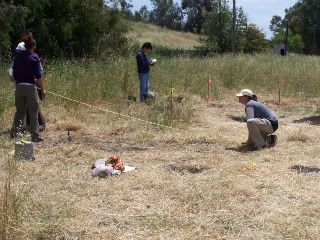
Screening material from Unit 1:
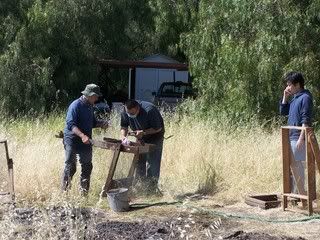
Taking end-of-level notes on Unit 3:
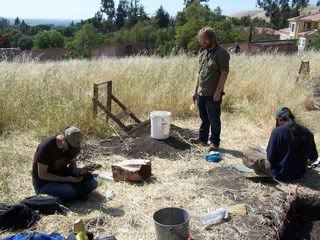
And opening up shop for a new day of excavation:
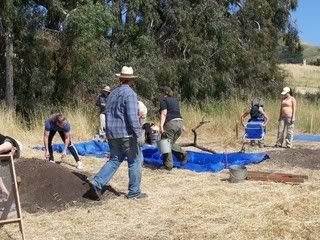
Plus, this turkey:
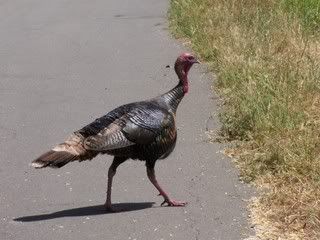
Which reminds me: What do you get when you cross a turkey with a centipede? A drumstick for everybody! Have a good Summer, everyone!
Here are some pictures of everyone hard at work. Measuring angles to determine excavation unit boundaries:

Screening material from Unit 1:

Taking end-of-level notes on Unit 3:

And opening up shop for a new day of excavation:

Plus, this turkey:

Which reminds me: What do you get when you cross a turkey with a centipede? A drumstick for everybody! Have a good Summer, everyone!
DSCQHR: Epilogue or Epitaph?

as i sit here getting ready to hand in my field note book and finishing up my site report a little waxing on Saturday's events feels appropriate. though i really enjoyed the whole season and truly just now feel ready to begin to excavate with any understanding of how to do it effectively and efficiently, i gotta say that Saturday 11 June 2011 was possibly my best day yet. Charles, his lovely wife Estela, David's B and P, Brenna, Dani, Promise, Ken, thank you so much for helping me to gain closure on an life event that feels as though it is really the beginning of a next phase of my life. doing the profiles and getting to shovel all that soil and muck back into the holes, er units and trench was great. even the repatriation part was the best. thanks to everyone so much for helping me to learn some stuff this past ten weeks. i have this strong desire to go back and do more digging at DSCQHR ... who knows what may happen in the future? ...
Site DSCQHR: really just a dump?
Hey, look who figured out Blogger, finally!
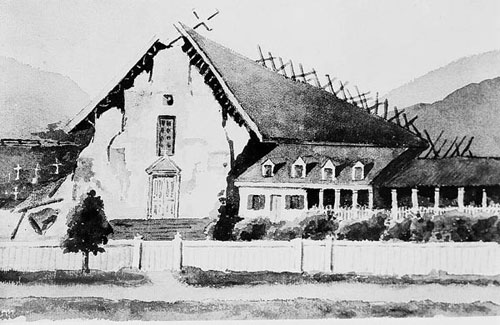
Contemporary image of Mission San Jose following its collapse in the 1868 earthquake.
Here's a thought I had about the deposition at our site, while writing up my analysis section of the site report. Suppose instead of being deposited here in order to building something on top of it, our large area of apparently secondary materials was actually rubble moved here just to clear away somewhere else that someone did want to build/plant on? It would explain why, aside from the road, we haven't found any structures or obvious signs of viticulture such as actual vines, trellises, or other grape-related paraphrenelia. Burning a trash heap is also something people do. Here is the relevant section of my report, with the connection to my own unit:

Contemporary image of Mission San Jose following its collapse in the 1868 earthquake.
Here's a thought I had about the deposition at our site, while writing up my analysis section of the site report. Suppose instead of being deposited here in order to building something on top of it, our large area of apparently secondary materials was actually rubble moved here just to clear away somewhere else that someone did want to build/plant on? It would explain why, aside from the road, we haven't found any structures or obvious signs of viticulture such as actual vines, trellises, or other grape-related paraphrenelia. Burning a trash heap is also something people do. Here is the relevant section of my report, with the connection to my own unit:
It is possible that refuse has been dumped on our site area from the mission period onward, but that seems unlikely given its uphill location from the mission settlement. More likely, all of the material, mission, rancho and all, was moved at some point as a whole mass. It is worth considering the fact that we do know for certain, that there was much and sometimes rapid land exchange during the period following secularization, and again following the Gold Rush era. It is also poignant that so little explicitly agricultural has emerged, given the centrality the question of the vineyard has had in some of the proposed hypotheses for this site. I think it is worth considering a hypothesis that I have not yet heard anyone advance, that this midden already existed somewhere down the hill when a land exchange put it in the hands of a new owner, who rather than wanting it to build up a terrace or roadbed, simply wanted it out of their way. Our site may not be the result an attempt to conduct agricultural activities here on Site DSCQHR, but merely an attempt to clear away some old middens or earthquake rubble in order to make some space for agricultural activities somewhere else. Our site may have had value simply as an unused field, as indeed it still is, somewhere a new owner of more valuable agricultural land elsewhere could dump an old trash heap without it being in anyone's way. Nevertheless, this suggestion is also based more on absence of evidence than evidence, and lacks any secondary historical sources to back it up.
According any of the interpretations so far advanced, U3 can be understood as further evidence of this unknown refuse/fill deposition process, and I think the more productive burnt area, especially considering the number of burnt bone and glass, probably represents kitchen refuse. I do not now believe that a feature exists in the unit in the sense of something having purposefully placed there as its original depositional environment, given the lack of any clearly defined boundaries, stratigraphic markers, or widespread regular patterns in artifact distribution beyond certain artifact type clusters and scatters.
Sunday, June 12, 2011
Trench
On May 7th and 14th I worked on Trench 1 with many different people. On the 7th I mostly just dug. We were supposed to be digging from 10-20 cm deep but we had to level out the trench to make the entire thing 10cm deep first. We then dug to 20cm and on the 14th down to 30cm deep. On both days we were able to find a few things on the eastern most end. Overall there were three terracotta pieces almost in line, a cement block, a concrete fragment, pieces of asphalt, and a spike. There was also a large amount of some kind of rock or stone that would break when hit with a shovel. The only problem was that it had to be hit really hard, which made digging out the eastern most end really difficult and frustrating. It is possible that the rock was a foundation of some kind but I do not know. There were other finds as well such as a lot of glass of different colors, nails, ceramic pieces, and bones. There were two animal vertebrae that were fairly large compared to the other small bits of bones we had been finding. On the 14th David's daughter came and helped dig. She mostly shoveled loose dirt into a bucket which was actually quite helpful. It was nice to see her having fun digging and being in such an environment. It must have seemed like a really long sandbox filled with dirt. I liked the trench better than the regular unit because there was more space to work in and more things to do.
I was glad when we finally began digging excavation units on 5/7/11. I worked on unit 1 with Amanda, Andrew and Hiroto. First we had to measure out a 2x1 meter perimeter. We then put in nails or stakes (I can't remember which) in the corners and strung pink string from each one to outline the unit. The dirt was very dry and compact on the surface which made it difficult to dig out. It was easier to use the pick axe than a shovel. The large clumps of dried dirt were also hard to screen and had to be broken up by hand, which sometimes felt like breaking rocks. We were able to find a few interesting things on the level 0-10 cm below surface. We found a bolt, a few pieces of glass, a few animal bones, and a lot of what looked like pieces of brick but we only bagged a few. We were unable to dig the pit to 10 cm deep the first day but I think we did a good job considering how difficult it was to dig out and screen the dry dirt and considering we didn't actually start digging until after lunch. It was my first real archaeological experiance and I thought that it went really well even if we didn't find much or dig to deep.
Subscribe to:
Posts (Atom)